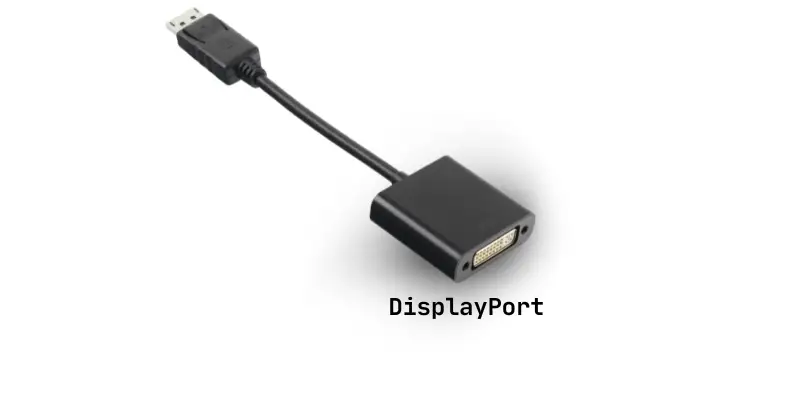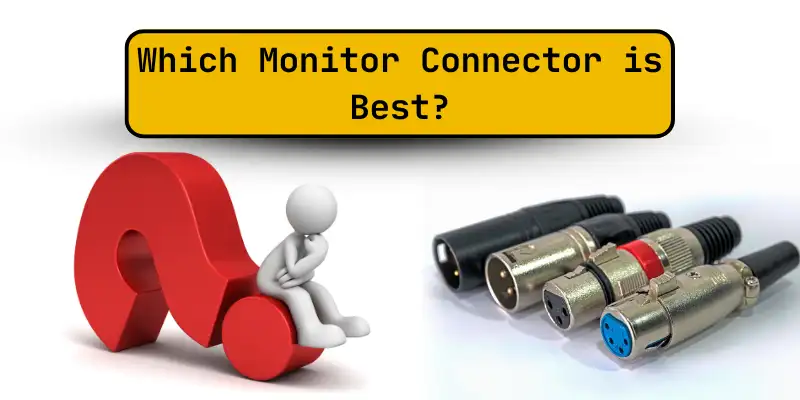Types of Monitor Connectors
Published: 5 Feb 2025
Is your screen blurry? No signal? Slow display? The problem might not be your monitor—it could be the monitor connector you are using. Many people have display issues because they use an old or wrong connector. If you want clear pictures for work, fast speed for gaming, or an easy setup for daily use, choosing the right monitor connector is very important.

What is a Monitor Connectors?
A monitor connector is a cable or port that connects a computer to a monitor. It helps the computer send pictures to the screen. Some common types are HDMI, VGA, and DisplayPort. Each one works in a different way. The right connector makes the screen look clear and smooth.

Types of Monitor connectors
Monitor connectors are divided into different categories based on their technology and usage. Some are analog, while others are digital. Modern connectors offer better resolution and faster data transfer. Below are the main types of monitor connectors categorized accordingly.
- Analog Connectors
- Digital Connectors
Analog Monitor Connectors
Analog connectors transmit video signals as continuous electrical waves. They were commonly used in older monitors and televisions. These connectors provide lower image quality compared to digital ones. However, some devices still support them for compatibility.
List of Analog Connectors
- VGA
- Composite Video
- S-Video
- Component Video

VGA (Video Graphics Array)
VGA is an old type of monitor connector. It helps the computer send pictures to the screen. This connector uses an analog signal to show images. VGA has a blue-colored plug with 15 small holes. Many older computers and monitors still use it. However, new monitors now use better connectors for clearer pictures.

Composite Video
Composite video is an old type of connector. It sends video signals using a single cable. The cable is usually yellow and works with older TVs and monitors. It does not support high-quality pictures. The image may look blurry or unclear compared to modern connectors.

S-Video
S-Video is a type of cable that sends video signals. It separates brightness and color for a better picture. This connector was popular in old TVs and DVD players. It does not carry sound, only video. Many new devices do not use S-Video today.

Component Video
Component video is a way to send video signals from one device to another. It uses three separate cables for colours: red, blue, and green. These cables help show clear and bright pictures on the screen. It is better than older video cables like composite video. Many old TVs and DVD players still use component video.

Digital Monitor Connectors
Digital connectors transmit video signals as binary data (0s and 1s). They provide better image quality, higher resolution, and faster data transfer compared to analog connectors. Most modern monitors and devices use digital connectors for clear and sharp displays. These connectors support advanced features like HD, 4K, and even 8K resolutions.

List of Analog Connectors
- HDMI
- DVI
- DisplayPort
- Mini DisplayPort
- USB-C
- Thunderbolt
HDMI (High-Definition Multimedia Interface)
HDMI is a popular connector for monitors, TVs, and gaming consoles. It carries both video and sound in one cable. This makes it easy to use. HDMI supports high-quality pictures, like HD and 4K. Most modern devices have an HDMI port.

DVI (Digital Visual Interface)
DVI is a type of monitor connector. It helps send video signals from a computer to a screen. It can send both digital and analog signals. Many old and new monitors support DVI. It gives a clear picture but does not carry sound.

DisplayPort
DisplayPort is a type of cable that connects a computer to a monitor. It helps send video and sound from the computer to the screen. This connector shows clear and smooth pictures. Many modern computers and monitors use DisplayPort. It is fast and supports high-quality displays like HD and 4K.

Mini DisplayPort
The Mini DisplayPort is a small connector used to connect a computer to a monitor or other screen. It sends high-quality video and audio signals. The Mini DisplayPort is similar to the regular DisplayPort but is much smaller. It is often used in laptops and smaller devices. This connector helps show clear images on the screen.

USB-C (Universal Serial Bus Type-C)
USB-C is a modern connector used for many devices, including monitors. It is small and round with a reversible design, meaning it can be plugged in either way. USB-C supports both power and data transfer, making it very useful. It can carry high-quality video signals and is used for clearer pictures on newer monitors. This connector is becoming more common in laptops and other devices.

Thunderbolt Connector
Thunderbolt is a fast connector used to connect devices to a computer. It can transfer data, video, and power all at once. Thunderbolt works with many types of devices like monitors, hard drives, and laptops. It is faster than many other connectors, allowing for quicker file transfers and clearer displays. Thunderbolt helps connect high-performance devices easily.

Best Types of Monitor Connectors
If you want the best display experience, DisplayPort is the perfect choice. It supports high resolutions, smooth refresh rates, and deep colours, making everything look clear and sharp. Unlike other connectors, it handles multiple monitors easily with a single cable. Gamers and professionals love it for its speed and performance. I highly recommend DisplayPort for a top-quality, future-proof setup!

How do I choose the right type of Monitor connector?
Choosing the right monitor connector is important for a clear and smooth display. Different connectors work with different devices. Some give better picture quality, while others are older and slower. Before choosing, check what your monitor and computer support. The right connector will make your screen look its best!
Steps to Choose the Right Monitor Connector
- Check your monitor ports: Look at the back of your monitor. See what types of ports it has, like HDMI or VGA.
- Look at your device ports: Check your computer or laptop. Find out which connectors it supports.
- Consider your needs: If you want high-quality images, go for HDMI or DisplayPort. If you just need a basic connection, VGA may work.
- Think about future upgrades: Choose connectors like DisplayPort or USB-C. These can support better resolutions and are more future-proof.
- Get the right cable: Make sure the cable fits both your computer and monitor connectors.
Conclusion
So, guys, it’s time to finish up! In this article, we’ve covered types of monitor connectors in detail. The right connector makes your screen look much better. I think HDMI or DisplayPort are great choices. Make sure to check your devices before deciding. Now, pick the connector that works best for you!
Frequently Asked Questions about types of monitor connectors
Here are some of the most commonly asked questions about types of monitors:
Can I use any connector for my monitor?
No, you need to use a connector that fits both your monitor and computer. Check the ports on your devices first. Make sure the cable matches the type of connector for both.
Why should I choose DisplayPort?
DisplayPort is great for high-quality video and multiple monitor setups. It supports higher resolutions and faster refresh rates. It’s a perfect choice for gaming and professional work.
What connector is best for gaming?
For gaming, DisplayPort or HDMI are the best options. They both support high refresh rates and clear images. DisplayPort is especially great for high-end gaming setups.
Can I connect a monitor to my laptop using USB-C?
Yes, USB-C can be used to connect your laptop to a monitor. It supports video, data, and power all in one cable. Make sure your laptop and monitor both have USB-C ports.
What is Thunderbolt used for?
Thunderbolt is a very fast connector that can transfer video, data, and power. It’s great for connecting high-performance devices, like monitors and external drives. It’s faster than HDMI or USB-C.
Do I need a special cable for each type of connector?
Yes, each type of connector has its own cable. HDMI, VGA, and DisplayPort cables look different and fit into different ports. Always check which cable matches your devices.
What is the best connector for watching movies?
For watching movies, HDMI is a great choice. It supports both high-definition video and sound. It’s perfect for connecting a computer to a TV or large monitor.
Can I use a VGA connector with a modern monitor?
Yes, you can use a VGA connector, but the picture quality won’t be as sharp as newer connectors. VGA is an older analog connector, and modern monitors work best with digital connectors like HDMI or DisplayPort. It’s better to use a digital connector for clearer images.

- Be Respectful
- Stay Relevant
- Stay Positive
- True Feedback
- Encourage Discussion
- Avoid Spamming
- No Fake News
- Don't Copy-Paste
- No Personal Attacks

- Be Respectful
- Stay Relevant
- Stay Positive
- True Feedback
- Encourage Discussion
- Avoid Spamming
- No Fake News
- Don't Copy-Paste
- No Personal Attacks
